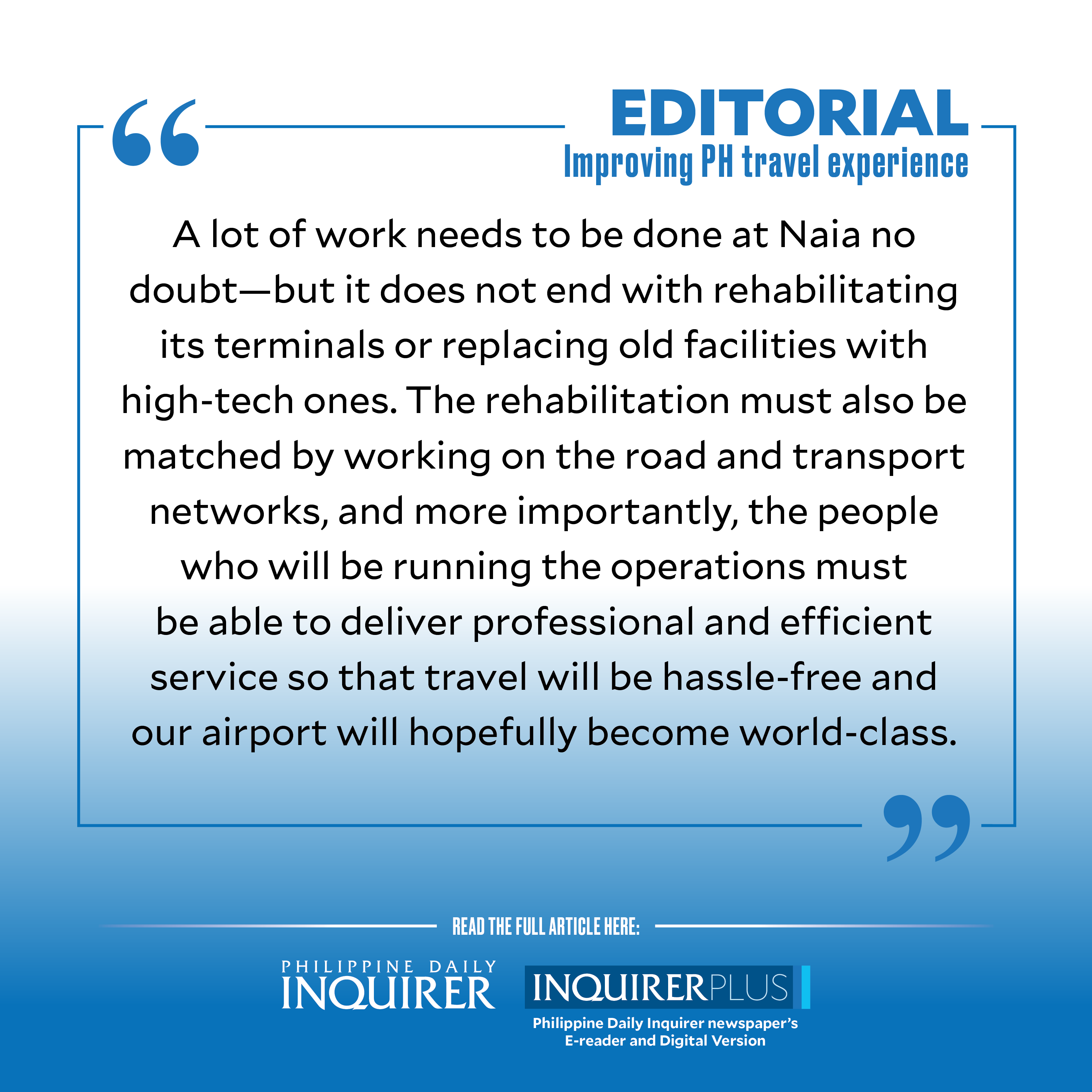Improving PH travel experience

A piece of good news this week: The government has greenlighted a multibillion proposal for the much-needed and long-delayed rehabilitation of the Ninoy Aquino International Airport (Naia) through a public-private partnership. Is that a collective sigh of relief we hear from Filipinos who had to bear the ignominy of coming from a country whose international airport has been dubbed as the world’s worst?
This development is expected to be included in President Marcos’ State of the Nation Address on Monday, and it will surely earn approval from Filipinos who have long endured delayed or canceled flights at the country’s international and domestic air terminals sagging under the weight of poorly maintained and old facilities that can barely keep up with the flow of passengers and demands of modern travel.
Article continues after this advertisementSocioeconomic Planning Secretary Arsenio Balisacan said the P170-billion solicited proposal to rehabilitate Naia’s operations and management will “address long-standing issues” such as the inadequate capacity of passenger terminal buildings and restricted aircraft movement. This means that the unsolicited proposal of the Manila International Airport Consortium composed of a group of tycoons has been rejected though they could still bid for the project.
While Naia’s rehabilitation will not be immediate—the government hopes to award the project to the winning bidder by December and to have it take over by next year—the news is something to look forward to after all the recent issues that have hounded Naia including delayed or canceled flights, long immigration queues, offloading of passengers, lack of waiting areas, etc. The list is long but perhaps the most serious yet was the power outage on New Year’s Day that crippled operations for about eight hours affecting hundreds of flights and thousands of travelers, followed by two more similar incidents in May and June.
The latest issue to hound travelers is the revival of a 20-year-old security check policy: the mandatory removal of shoes. Security check is, of course, a matter of safety that all passengers should submit themselves to. But this once more points to Naia’s lack of modern equipment that meets the requirements of a modern world constantly facing threats of terrorism. A backscatter passenger scanner, for example, used to detect threats such as weapons or explosives that a person could be carrying under their clothing, costs anywhere between $150,000 and $200,000, or from P8 million to P10 million—money that the Manila International Airport Authority (MIAA) does not have. It cannot even support the upkeep of the terminals’ facilities, how much more acquire expensive machines?
Article continues after this advertisementThese problems all point to the immediate need to improve Naia’s facilities and replace problematic or old equipment, as well as boost passenger capacity.
To be fair, there have been marked improvements over the years such as the so-called e-gates that allow faster contactless immigration transactions by allowing passengers to swipe their passports, have their biometrics taken, and undergo facial capturing. Last December, Naia authorities also removed the security machines at the entrance to the terminals to avoid the chaotic bottleneck of passengers, leaving only one final security check after the immigration area. This considerably limited the bottlenecks at security checks but complaints of long lines at immigration counters remained due to the shortage of officers manning them.
Naia’s rehabilitation, which eyes the increase of current annual passenger capacity to at least 62 million from 35 million, even becomes more urgent with passenger volume inching closer to pre-pandemic levels. MIAA reported that international and domestic passengers soared by 78 percent to 22.22 million from January to June. This figure, reports said, is only 8 percent lower compared to the number of passengers registered in the same period in 2019. The flight movements were also up 42 percent to 135,883 for the period, which was at the same level that Naia handled in the first half of 2019.
With the demand for travel up, it will be an embarrassment if Naia—the country’s main international hub—is unable to meet the volume of passengers at a comfortable level. Its reputation as the world’s worst airport already precedes it and recent reports of delayed flights do not help improve its standing. The Philippines, if it wants to take advantage of the recovery of the tourism sector post-pandemic, needs to keep up. The country already boasts beautiful tourist attractions but tourists will not be interested in visiting if the infrastructures are below par—including transport and road networks.
A lot of work needs to be done at Naia no doubt—but it does not end with rehabilitating its terminals or replacing old facilities with high-tech ones. The rehabilitation must also be matched by working on the road and transport networks, and more importantly, the people who will be running the operations must be able to deliver professional and efficient service so that travel will be hassle-free and our airport will truly be world-class.
















